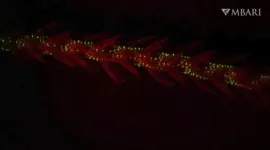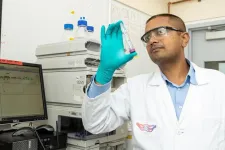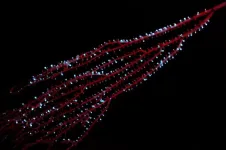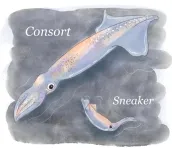(Press-News.org) An international team of researchers, led by Danielle DeLeo from the Smithsonian Institution, has identified eight organisms with previously unknown luminosity. Using genetic findings from these organisms and previous studies, they estimated that coral bioluminescence originated about 540 million years ago in the Cambrian period, making them the earliest bioluminescent organisms. During this period, they shared the oceans with invertebrates with light-sensitive eyes, hinting that interspecies interactions occurred involving light. They published their findings in Proceedings of the Royal Society B.
While shallow-water corals rarely exhibit bioluminescence, deep-sea varieties can be filled with vibrant colors and captivating displays. The purpose of these colorful glow-in-the-dark coral displays has long intrigued researchers. Researchers have theorized that the displays may attract large predators to scare away the smaller marine life that eat the coral or draw in prey.
The genetic research was based on discoveries by Manabu Bessho-Uehara, a researcher from Nagoya University (at the time of the study), and Andrea Quattrini, from the Smithsonian Institution. In a previous study, Bessho-Uehara identified several new bioluminescent corals in the deep sea. Based on this finding, he suspected the existence of numerous unidentified bioluminescent corals.
Bessho-Uehara and Quattrini performed fieldwork from the shallow to the deep sea floor including Nagoya University’s Sugashima Marine Station, near the city of Toba in central Japan to find more bioluminescent specimens. They found previously unidentified bioluminescence in two types of Hexacorallia (soft corals) and five types of Octocorallia.
“I was excited, as we were the first to discover bioluminescence at the genus level in five genuses: Bullagumminzoanthus, Keratosidinae, and Corallizoanthus corals as well as Echinoptilum sea pens, and Metallogorgia deep sea fans.” said Bessho-Uehara about the discovery.
Using the team’s findings in modern organisms, a multidisciplinary team that included the Smithsonian’s National Museum of Natural History, Florida International University, Monterey Bay Aquarium Research Institute, University of California, and Harvey Mudd College used genetic information from these organisms to construct a phylogenetic tree to trace the origins of bioluminescence in anthozoans, the class of marine organisms that includes corals and similar organisms.
A phylogenetic tree is like a family tree except that it uses evolutionary relationships based on genetic data instead of bloodlines. It serves as a visual representation of the evolutionary connections and shared ancestry among diverse groups of organisms.
The researcher’s findings suggest that bioluminescence first originated in a common ancestor of Octocorallia corals. Using these data and the fossil record, the team found that the ancient coral existed during the Cambrian period, approximately 540 million years ago, making it the earliest known bioluminescent organism.
When he was told the results, the first thought that Bessho-Uehara had was that “the ocean is full of wonder.” He continued, “I remember feeling so amazed when we discovered bioluminescence emerging twice as long ago as previously thought.”
Their findings also offer insights into the evolution of organisms, which occurred primarily in the sea during the Cambrian era. During this period, invertebrates developed eyes with light-sensitive photoreceptors. This suggests the exciting possibility of light-mediated interactions between anthozoans and organisms with photoreceptors, shedding new light on the ecology of a crucial period in the evolution of life.
END
Coral identified as oldest bioluminescent organism, suggesting a new model of ancient ecology
2024-04-24
ELSE PRESS RELEASES FROM THIS DATE:
SRI chosen by DARPA to develop next-generation computational design of metallic parts and intelligent testing of alloys
2024-04-24
SRI announced today that it has been selected by the Defense Advanced Research Projects Agency (DARPA) to deliver advanced technology for its recently launched Multiobjective Engineering and Testing of ALloy Structures (METALS) program.
DARPA METALS aims to break today’s one-material-per-part paradigm, which can lead to vulnerabilities and reduced life when highly engineered components experience austere environments. The goal of the four-year program is to develop technologies that treat material selection – particularly metallic alloys – as a continuous ...
NJIT engineers muffle invading pathogens with a 'molecular mask'
2024-04-24
Vaccines remain the gold standard of protection against dangerous pathogens, but take considerable time and vast resources to develop. Rapidly mutating viruses such as SARS-CoV-2 can blunt their effectiveness and even render them obsolete.
To address these gaps, a multi-university team led by New Jersey Institute of Technology’s Vivek Kumar is developing a hydrogel therapy that acts as a first line of defense against viruses and other biological threats. The peptides that make up this gel prevent viruses ...
Perinatal transmission of HIV can lead to cognitive deficits
2024-04-24
WASHINGTON –Perinatal transmission of HIV to newborns is associated with serious cognitive deficits as children grow older, according to a detailed analysis of 35 studies conducted by Georgetown University Medical Center neuroscientists. The finding helps pinpoint the geographic regions and factors that may be important for brain development outcomes related to perinatal HIV infection: mother-to-child HIV transmission during pregnancy, labor and delivery, or breastfeeding.
The findings appeared in eClinicalMedicine on April 23, 2024.
Mostly because of advances in antiretroviral therapies, AIDS, which is caused by HIV infection, has ...
The consumption of certain food additive emulsifiers could be associated with the risk of developing type 2 diabetes
2024-04-24
In Europe and North America, 30 to 60% of dietary energy intake in adults comes from ultra-processed foods. An increasing number of epidemiological studies suggest a link between higher consumption levels of ultra-processed foods with higher risks of diabetes and other metabolic disorders.
Emulsifiers are among the most commonly used additives. They are often added to processed and packaged foods such as certain industrial cakes, biscuits and desserts, as well as yoghurts, ice creams, chocolate bars, industrial breads, margarines and ready-to-eat or ready-to-heat meals, in order to improve their appearance, taste and texture and lengthen ...
New cancer research made possible as Surrey scientists study lipids cell by cell
2024-04-24
Imagine being able to look inside a single cancer cell and see how it communicates with its neighbours.
Scientists are celebrating a new technique that lets them study the fatty contents of cancer cells, one by one.
A study led by the University of Surrey has sampled single live cancer cells and measured the fatty lipid compounds inside them. Working with partners at GSK and UCL, and developing new equipment with Yokogawa, the team saw how those cells transformed in response to changes in their environment.
Dr ...
Bioluminescence first evolved in animals at least 540 million years ago
2024-04-24
Bioluminescence first evolved in animals at least 540 million years ago in a group of marine invertebrates called octocorals, according to the results of a new study from scientists with the Smithsonian’s National Museum of Natural History.
The results, published today, April 23, in the Proceedings of the Royal Society B, push back the previous record for the luminous trait’s oldest dated emergence in animals by nearly 300 million years, and could one day help scientists decode why the ability to produce light evolved in the first place.
Bioluminescence—the ability of living things to produce light via chemical reactions—has independently ...
Squids’ birthday influences mating
2024-04-24
The day a male spear squid hatches determines which mating tactic he will use throughout his life, according to new research. Spear squid (Heterololigo bleekeri) that hatch earlier in the season become “consorts” which fight for mating opportunities. Those which hatch later become “sneakers,” which use more clandestine mating tactics. Researchers found that the mating tactic determined by the birth date was fixed for the squid’s whole life. Understanding how mating tactics are influenced by birth date, and the environmental conditions at that time, can help researchers consider ...
Star bars show Universe’s early galaxies evolved much faster than previously thought
2024-04-24
Embargoed until 00:01am BST on Wednesday 24 April 2024/19.01pm ET on Tuesday 23 April 2024
-With pictures-
The Universe’s early galaxies were less chaotic and developed much faster than previously thought, according to new research looking back more than ten billion years in time.
An international team of astronomers led by Durham University, UK, used the James Webb Space Telescope (JWST) to find evidence of bar formation when the Universe was only a few billion years old.
Bars are elongated strips of stars found in disc or ...
Critical minerals recovery from electronic waste
2024-04-24
RICHLAND, Wash.—There’s some irony in the fact that devices that seem indispensable to modern life—mobile phones, personal computers, and anything battery-powered—depend entirely on minerals extracted from mining, one of the most ancient of human industries. Once their usefulness is spent, we typically return these objects to the Earth in landfills, by the millions.
But what if we could “mine” electronic waste (e-waste), recovering the useful minerals contained within them, instead of throwing them away? A clever method of recovering valuable minerals from e-waste, developed by a research team at the Department ...
The move by Apple Memories to block potentially upsetting content illustrates Big Tech’s reach and limits, writes Chrys Vilvang
2024-04-23
How do algorithms determine the way we interact with our memories?
It’s a uniquely 21st-century kind of question, and it is far from settled.
In a new paper in the journal Memory, Mind & Media, Concordia PhD candidate Chrys Vilvang argues that the way tech companies store, package and share personal content back to users is opaque. And, given one recent controversy, it’s open to important questions about selection and representation.
Vilvang’s paper looks at the discussion stemming from an April 2022 article on 9to5Mac, a tech news site dedicated to all things Apple. Its journalists were given access to the iOS 15.5 beta update, and they discovered ...






